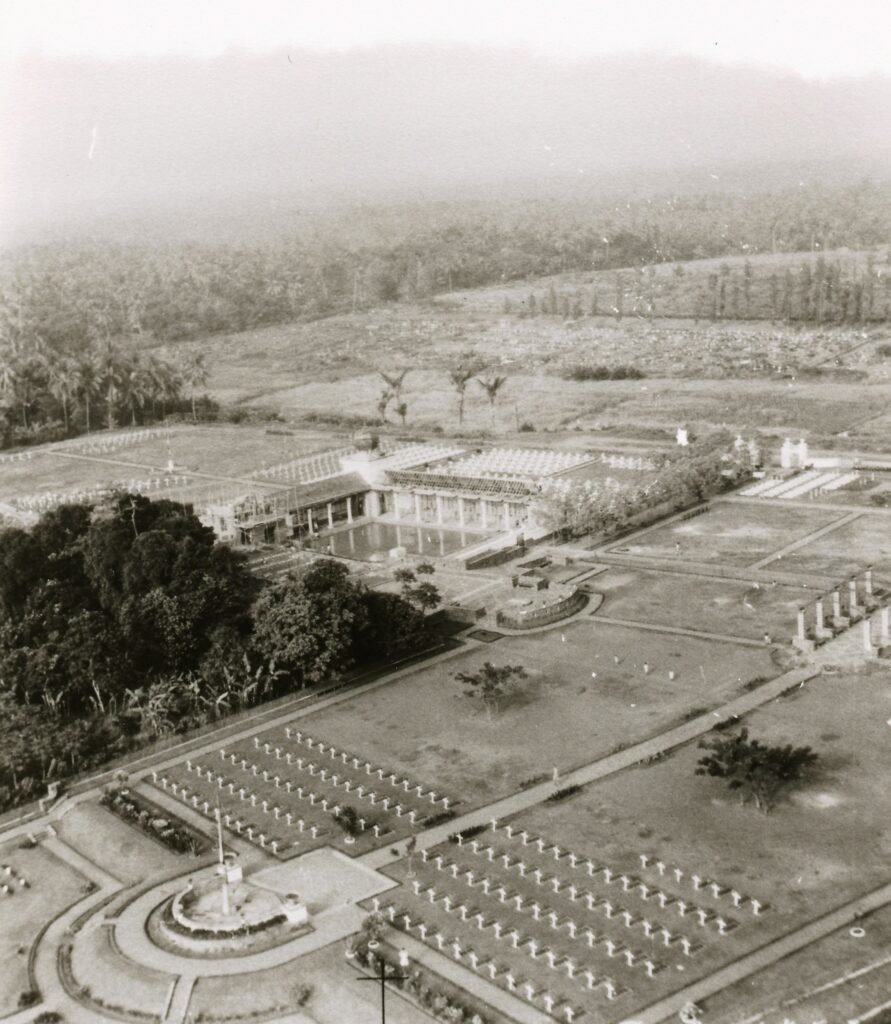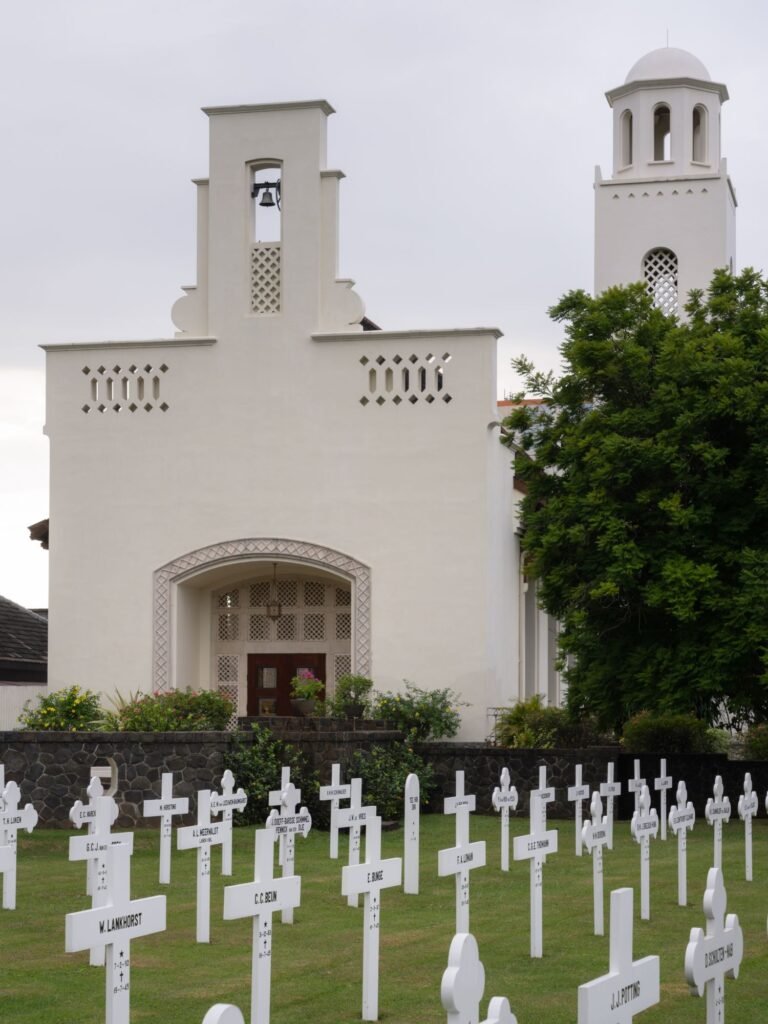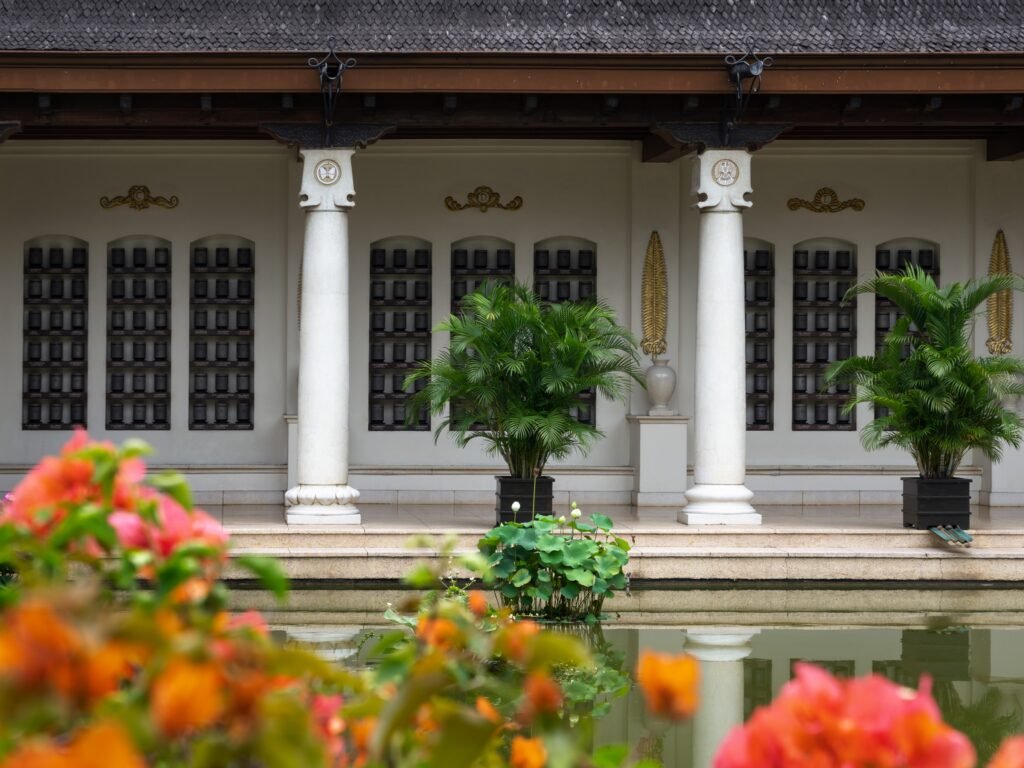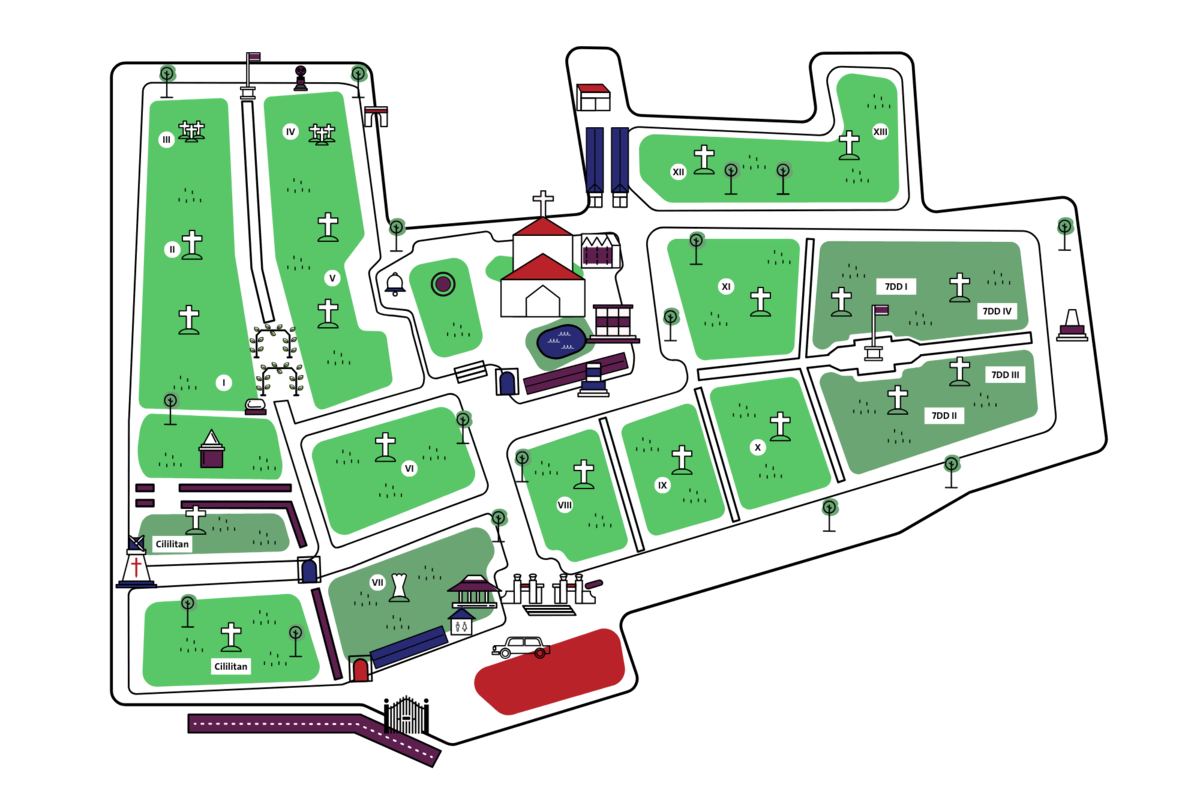Located in the heart of Jakarta, Ereveld Menteng Pulo is one of the most prominent Netherlands war cemeteries in Indonesia. It is known for its Simultaan Church and columbarium, which holds the ashes of Dutch prisoners of war who died in Japan. The cemetery serves as the main site for the Dutch national commemorations in Indonesia held annually on 4 May (Remembrance Day) and 15 August (Cessation of the Second World War in Asia). Nearly 4,000 war victims from the Second World War and the Indonesian National Revolution are buried here, including civilians, military personnel, and Lieutenant General S.H. Spoor, who laid the cemetery’s foundation stone and now rests among his fellow soldiers.
Video: How to get to Ereveld Menteng Pulo
The foundation of Menteng Pulo war cemetery was laid out by Reserve Lieutenant Colonel Ir. H. A. van Oerle, engineer commander C. of the 7 December Division. Under van Oerle’s guidance, the war cemetery was meticulously designed and developed in phases, positioning the Simultaan church and the columbarium at its heart, symbolising the core of remembrance and reflection.
Initially, this cemetery was situated on the outskirts of Jakarta, surrounded by palm trees, a tranquil spot seemingly in the middle of nowhere. However, with Jakarta’s rapid growth, the once-remote location is now enveloped by towering skyscrapers, placing the cemetery in the heart of the bustling city.
The site’s transformation began at the central mound, where a concrete building belonging to the Japanese once stood. After the building was dismantled, Ir. H.A. van Oerle began construction of the war cemetery, turning it into a sacred ground of commemoration.
The establishment of the cemetery was officially marked by Lieutenant General S.H. Spoor on 8 December 1947, an act that underscored the significance of this memorial site within the broader historical and cultural landscape of the region. As Commander-in-Chief of the Royal Netherlands East Indies Army (KNIL), Lieutenant General Spoor emphasised the diverse backgrounds of the war victims buried here and the equal respect given to all.


An important part of the cemetery’s history is the process of reburials, reflecting a collective effort to honour those who served and endured hardship. Initially, the Graves Registration Unit of the Royal Netherlands East Indies Army (KNIL) developed 22 war cemeteries across Indonesia. However, in a significant consolidation effort during the 1960s, at the request of the Indonesian government, these war cemeteries were merged into the current seven war cemeteries in Java, including Menteng Pulo.
This cemetery, in particular, has seen the reburial of war victims from Bandjermasin (1961), Tarakan (1964), Menado (1965), Palembang (1967), Balikpapan (1967), Makassar (1968), and Tjililitan (1968). This ensures that the final resting places of these individuals receive the utmost care and respect, while also enabling families to easily pay tribute to their loved ones.
The first civilians interred here were a couple, husband and wife van Harreveld, on 14 December 1946. Infantry soldier W. van Kammen was the first military to be buried at the cemetery, with the burial taking place on 11 February 1947.
Lieutenant General Spoor himself was laid to rest here among his men when he passed away on 25 May 1949, further solidifying the cemetery’s importance as a symbol of remembrance and unity. These burials mark the beginning of a sanctuary where history, reflection, and respect converge.
At the centre of Menteng Pulo war cemetery stands the Simultaan Church, a quiet and symbolic place for reflection and remembrance. Built from white plastered brick and completed in 1950, the church is not used for regular religious services but is opened for Dutch national commemorations and other special occasions.
Its design is simple and thoughtful. Inside the rectangular space, a modest altar encourages visitors of all backgrounds to pause and reflect on the lives commemorated here.
The church is rich with symbolic details that speak to life and creation. At the entrance, wrought iron doors are decorated with motifs representing nature: the right side features birds, native animals, and trees, while the left side shows fish, plants, and fruit, inviting reflection on the beauty and variety of life.
Symbolism continues within the church interior. Along the right-hand wall, facing the columbarium, visitors can find several symbolic elements, among them, an hourglass representing the passage of time. Another symbol is a butterfly, a traditional representation of the soul, encircled by an ouroboros, a serpent forming a closed loop by eating its own tail, symbolising eternity and the enduring nature of the soul. Together with other symbolic details, these elements contribute to the church’s atmosphere of remembrance and quiet reflection.
The church bell, once housed in the tower, is now placed just outside the building where visitors can see it up close. It is still used during Dutch national commemorations, its sound marking moments of honour and remembrance.
This space, shaped by architecture and symbolism, offers a place where memory, meaning, and quiet reflection come together.


Next to the Simultaan Church stands the columbarium, a quiet and meaningful part of Menteng Pulo war cemetery that reflects both resilience and remembrance. This graceful structure, supported by white round pillars, holds 754 urns containing the ashes of Dutch prisoners of war who died in Japan. The urns were found by U.S. troops and later brought to Indonesia to be laid to rest here.
The columbarium offers a calm space for reflection. Inside, and also in parts of the church, visitors will find mosaic windows created in 1949 by Dutch glass artist C. Stauthamer. These artworks are not only visually striking but also rich in meaning. In the columbarium, the mosaic windows symbolise the sense of brotherhood that has grown between Indonesia and the Netherlands.
This part of the war cemetery invites visitors to pause and reflect on the stories of courage and loss it represents, a space that connects the past and present, and personal remembrance with shared memory.


This central monument serves as the focal point for Dutch National commemorations at Menteng Pulo war cemetery. The Dutch national flag is displayed here only during national ceremonies and special visits. The area in front of the monument is commonly used for placing wreaths, commemorating the memory of those who perished.


Featuring an actual propeller from a fallen plane from the Indonesian National Revolution era, the Aviation Monument highlights the vital role of aviators. This section of the cemetery is also the final resting place for many victims from the Cililitan Air Base.


This monument is dedicated to the Department of Shipping and stands in memory of those who lost their lives between 1940 and 1945. It serves as a solemn tribute to the maritime personnel who faced perilous conditions during the war.


The Glodok Memorial commemorates war victims, particularly those interned at the Glodok camps. These internees suffered during World War II, and the plaque serves as a reminder of their hardships and resilience.


This poignant statue depicts the suffering of children during wartime, illustrating the impact of malnutrition and the loss of innocence. A hand on the left side of the statue symbolises death’s reach, emphasising the tragedy faced by the youngest victims of war.


A replica of the original Burma-Thailand Cross, made by prisoners of war from the wood of the Burma-Thailand railway. This cross is a tribute to those who perished during the construction and maintenance of the railway, reflecting the harsh conditions endured by the forced labourers.


This urn serves as a memorial for the unknown soldiers, featuring a relief of a woman raising both her hands with a torch in her right hand. The inscription above reads “Their Spirit has Overcome,” echoing the motto of the Graves Registration Unit of the Royal Netherlands East Indies Army (KNIL).


These two plaques of black natural stone bear the names of army soldiers who died but whose remains were never found and who don’t have a grave at the war cemeteries.


Commemorating the First ‘7 December’ Division, this monument remembers those sent to the former Dutch East Indies between 1946 and 1950. The division is named after Queen Wilhelmina’s speech in London on 7 December 1942. This speech became the guiding mandate for the conscripts of the 7 December Division.


 Gate
Gate
 Parking Area
Parking Area
 Main Gate
Main Gate
 First Stone
First Stone
 Pendopo, Information Centre & Guest Book
Pendopo, Information Centre & Guest Book
 Toilet
Toilet
 Aviation Monument
Aviation Monument
 Shipping Monument
Shipping Monument
 Glodok Memorial
Glodok Memorial

Rosarium
 Simultaan Church
Simultaan Church
 Flag Monument
Flag Monument
 Child of War Statue<
Child of War Statue<
 Evereld & CWGC Connecting Gate
Evereld & CWGC Connecting Gate
 Bell
Bell
 Columbarium
Columbarium
 Garden & Pond
Garden & Pond
 The Royal Netherlands Army Monument
The Royal Netherlands Army Monument
 The 7 December Division (7DD) Flagpole
The 7 December Division (7DD) Flagpole

7DD Monument
 Ereveld Menteng Pulo Manager's Office
Ereveld Menteng Pulo Manager's Office

Grave Sign Workshop
General Visits:
During visiting hours, Menteng Pulo war cemetery welcomes individuals and small groups to explore the grounds at their own pace. Visitors are invited to take time for quiet reflection on the histories and personal stories commemorated here. The peaceful pathways and memorials offer a contemplative space for anyone wishing to pay their respects.
Group Visitation and Tours:
For those interested in a more structured visit or group tours, it’s important to note the staff’s working hours. During these times, we may be able to accommodate group visits with a guided tour led by the war cemetery manager (with prior notice and confirmed availability). These tours offer a deeper insight into the significance of the site and the stories of those commemorated here, making them ideal for educational groups, organisations, or anyone looking to understand more about this historical site.
Guided Tours with Partner Organisations:
For visitors whose schedules do not align with our staff working hours, or who prefer a professional guided experience, we have partnered with reputable local guides in Jakarta. Please let us know if you’re interested and we will redirect you to our partners.
If you’re interested in learning about the types of visits available at the war cemetery, please visit our Visit Us page.
Media coverage, research, flying drones, professional photography sessions and conducting events within the war cemetery requires permission. We appreciate your understanding and cooperation in maintaining the sanctity of this solemn space.
Every day, 7:00 AM to 5:00 PM
Webdeveloper.id menyediakan jasa pembuatan website profesional untuk bisnis Anda yang mencakup desain modern dan kekinian. Dengan pengalaman lebih dari 1500+ project dan portofolio yang kuat, kami memastikan situs web Anda akan menonjol dan memenuhi kebutuhan bisnis Anda.